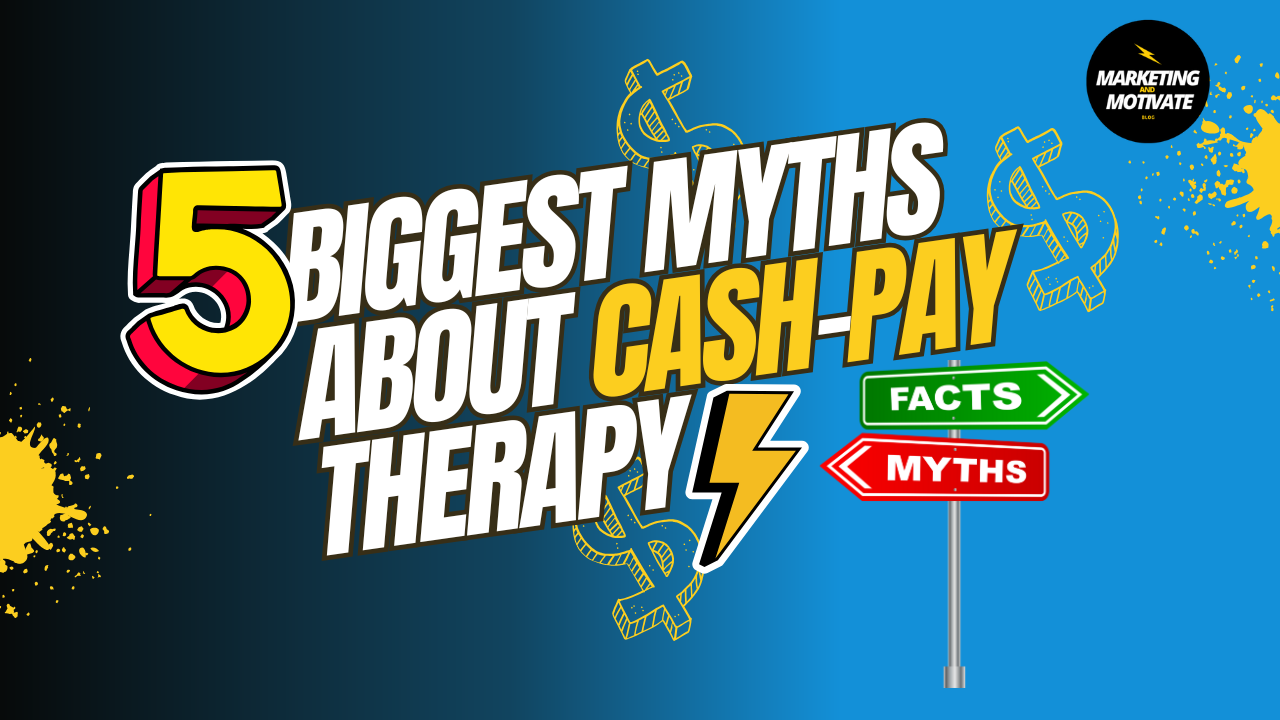The 5 Biggest Myths About Cash-Pay Therapy (And the Truth That Will Grow Your Practice)

For many mental health therapists, the idea of transitioning to a cash-pay therapy model sparks both excitement and fear. On one hand, the freedom, better income, and client alignment are incredibly appealing. On the other hand, misinformation and long-held assumptions create resistance.
Let’s be honest—if you’re thinking about ditching insurance and going private-pay, you've probably heard (or believed) a few of these myths yourself. But here’s the truth: Cash-pay therapy isn’t just possible—it’s a smarter, more sustainable path forward for most therapists.
In this article, we’re busting the 5 biggest myths about cash-pay therapy and sharing the truth that will empower you to build a profitable, ethical, and impactful private practice.
Myth #1: “No One Will Pay Out-of-Pocket for Therapy”
The Truth:
People pay for what they value—and mental health is no exception.
Let’s look at the facts:
- Americans spend billions annually on self-care, coaching, wellness retreats, and fitness programs.
- Many people already pay out-of-pocket for dental cleanings, massages, chiropractic adjustments, or life coaches—why not therapy?
- The rise in mental health awareness means more people understand the value of investing in long-term well-being.
The problem isn’t that clients won’t pay—it’s that therapists often don’t believe clients will pay.
Here’s what makes people happily pay for therapy:
- You clearly articulate the transformation you offer (e.g., reducing anxiety, improving relationships, setting boundaries).
- Your messaging connects with their pain points and aspirations.
- You show up confidently and position therapy as a necessary life investment.
Quick Tip:
Use client-focused language in your marketing. Replace “I help with anxiety” with “I help ambitious women overcome anxiety so they can lead with clarity and confidence.” Clients pay for outcomes, not session time.
Myth #2: “You Need to Be in a Wealthy Area to Go Cash-Pay”
The Truth:
Your niche and how you position your value matter more than your ZIP code.
Yes, urban or affluent areas might have a higher saturation of private-pay practices—but geography isn’t the barrier you think it is. Thanks to telehealth and strategic marketing, therapists are building cash-pay caseloads in rural, suburban, and middle-income areas across the country.
Here’s how:
- Niche down. When you specialize in solving a specific problem for a specific audience, people will seek you out—even if they live hours away.
- Go virtual. Teletherapy lets you expand beyond your immediate location. Clients want therapists who “get them” more than they want someone nearby.
- Communicate value. The key is to position therapy as a powerful transformation—not just a weekly expense.
Quick Tip:
Target a psychographic, not just a demographic. For example, market to “career-driven women in leadership roles” or “millennial parents facing burnout” rather than just “people in [city].”
Myth #3: “Cash-Pay Therapy Is Only for Elite or Niche Therapists”
The Truth:
You don’t need to be an EMDR specialist, trauma guru, or coach to thrive in cash-pay therapy. You need clarity, confidence, and strong messaging.
There’s a dangerous assumption that only “high-end” or “celebrity” therapists can make private-pay work. In reality, many generalists are building wildly successful cash-pay practices by:
- Solving one key pain point very well (e.g., helping new moms manage postpartum anxiety).
- Branding themselves clearly and consistently.
- Creating offers and services that match the specific needs of their ideal clients.
What matters most:
- Your ability to articulate value.
- Your consistency in showing up.
- Your confidence in pricing your services according to the transformation you deliver.
Quick Tip:
Think like a guide, not a service provider. Clients don’t want a “licensed therapist who uses CBT”—they want a trusted expert who helps them sleep better, parent better, or finally feel at peace.
Myth #4: “Going Cash-Pay Means Losing Most of Your Clients”
The Truth:
Yes, you might lose some—but what you gain is better-fit clients, less burnout, and more income per session.
This fear is totally valid. Losing clients is scary. But here’s the shift:
You’re not losing your income—you’re shedding an unsustainable model that keeps you underpaid and overwhelmed.
Here’s what happens when you go cash-pay:
- You attract clients who are ready to commit and do the work.
- You work fewer hours but make more per session.
- You create space for creativity, self-care, and passion projects.
Many therapists transition by starting with a hybrid model, slowly increasing their private-pay clients while reducing insurance panels. Over time, their schedule fills with aligned, well-paying clients who respect boundaries and show up fully.
Quick Tip:
Do the math. If you currently see 25 clients a week at $80/session (insurance), that’s $2,000/week. With private pay at $150/session, you’d only need 13–14 clients to hit the same revenue—and with far less emotional fatigue.
Myth #5: “It’s Not Ethical to Charge Clients Without Insurance”
The Truth:
There is nothing unethical about charging a fair, transparent rate for a service that changes lives.
This myth is often rooted in guilt, people-pleasing, or fear of judgment—not fact. Here’s why charging cash-pay is ethical:
- It allows you to build a sustainable practice, so you don’t burn out and quit the profession.
- It removes third-party gatekeepers who control how you treat your clients.
- It creates room for you to offer pro bono or sliding scale spots—on your terms.
In fact, cash-pay therapists often feel more freedom to support underserved communities because they’re not drowning in paperwork or underpaid.
Ethical pricing includes:
- Clarity and transparency about your fees.
- Honoring your time, training, and emotional labor.
- Maintaining boundaries so you can show up fully for each client.
Quick Tip:
Think of your fee as a gateway to transformation, not a barrier. Your ideal clients will understand and respect your value when you believe in it first.
Busting Myths to Build a Stronger Practice
Here’s the bottom line: These myths are just mental roadblocks. They may feel real, but they’re not grounded in truth. And the longer you let them dictate your practice decisions, the longer you stay stuck in a model that doesn’t serve you—or your clients.
Let’s recap the truths:
✅ Clients will pay out of pocket when you show value.
✅ You don’t need to live in a wealthy area—just speak to your ideal client.
✅ You don’t need to be elite or niche—just clear and confident.
✅ You may lose some clients, but the right ones will find you.
✅ Cash-pay is not only ethical—it’s often more client-centered.
Your Next Step Toward Cash-Pay Confidence
If you’re ready to leave behind the hustle of insurance-based therapy and step into a practice filled with aligned clients, freedom, and purpose, here’s what you can do next:
🎯 Take the FREE Cash-Pay Therapy Readiness Quiz – Evaluate where you are and what you need to shift. --> Take Quiz
📣 Start showing up online with clarity—post content that speaks to your ideal client’s struggles and desires.
📆 Set a date for your transition plan, even if it’s six months away.
You’re not “just a therapist”—you’re a skilled professional changing lives every day. You deserve to be paid well, supported fully, and respected deeply. Going cash-pay can help make that a reality.
It’s time to ditch the myths, embrace the truth, and grow the thriving practice you were meant to build.
Ready to make the transition? Click the link below to take the Cash-Pay Readiness Quiz now. Discover your readiness score + tools to help you transition with clarity and confidence.
👉 Take the FREE Cash-Pay Readiness Quiz for Therapists to start your journey toward financial freedom and practice autonomy today!


